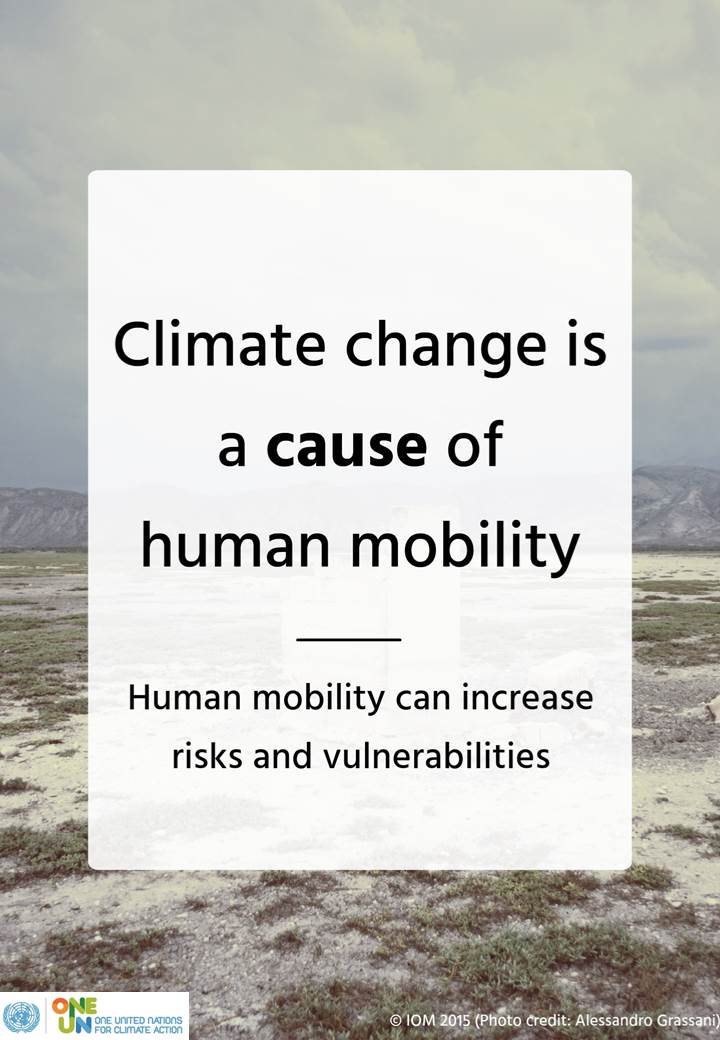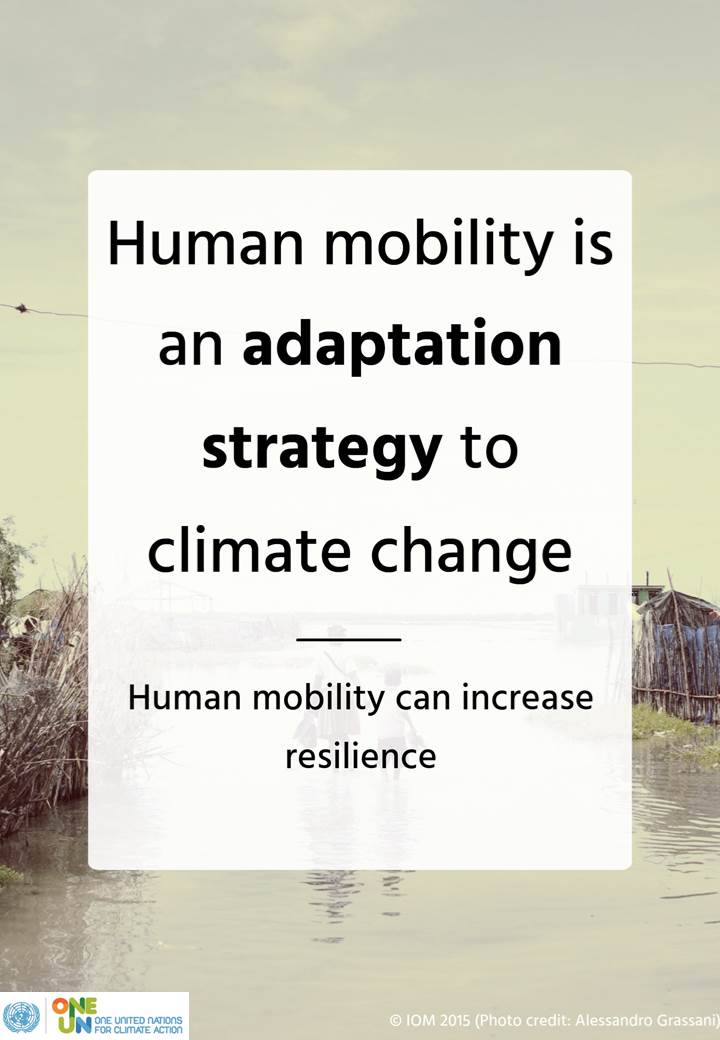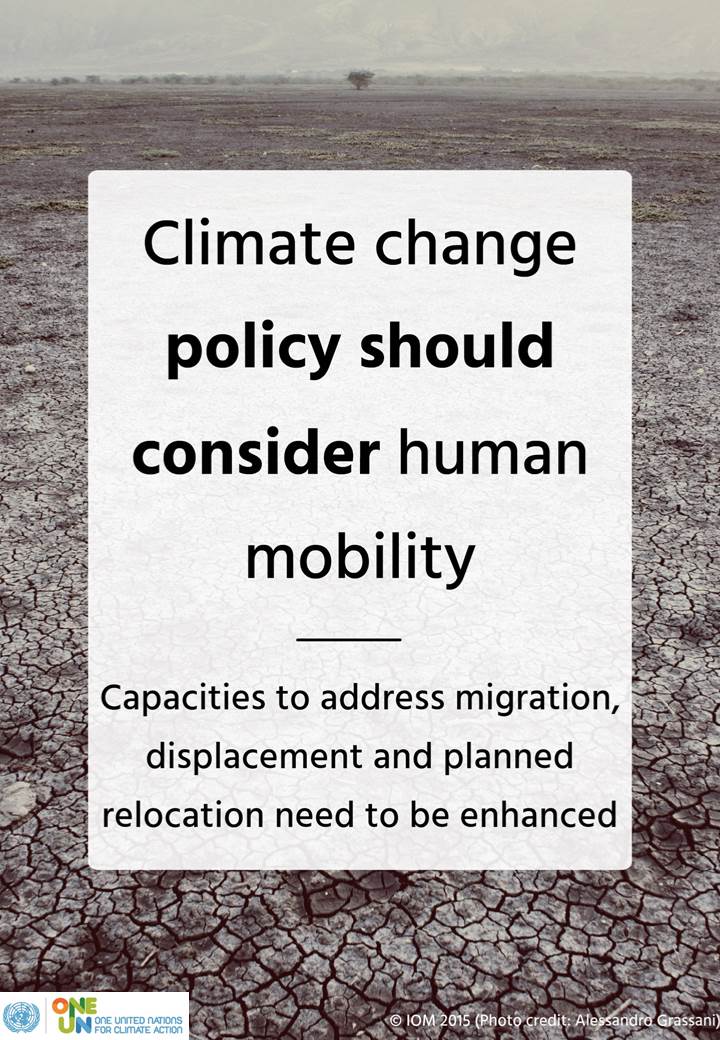-
Who We Are
WHO WE AREThe Environmental Migration Portal is a one-stop service website to promote new research, information exchange and dialogue, intended to fill the existing data, research and knowledge gaps on the migration, environment and climate change (MECC) nexus.
IOM Global
IOM Global
-
Our Work
Our WorkThe Environmental Portal aims to centralize relevant and up-to-date research, data, and information on migration, environment and climate change and
provide information on recent activities of IOM, including with its partners, in addressing the migration, environment and climate change (MECC) nexus.What we do
What we do
- Where We Work
- Data and Resources
- 2030 Agenda
Human Mobility in the UN Framework Convention for Climate Change
As the leading intergovernmental migration agency, The International Organization for Migration (IOM) has been at the forefront of operational, research, policy and advocacy efforts seeking to bring environmental migration to the heart of national, regional, and international concerns. Working in close collaboration with its Member States, observers and partners, IOM’s work on Migration, Environment and Climate Change (MECC) has greatly expanded in the past five years. To deepen IOM’s engagement with this thematic area, the “Migration, Environment and Climate Change Division” (MECC) was created within the organization. The MECC Division is a dedicated institutional structure tasked with leading IOM’s work on migration, environment and climate change. For more information, please see IOM and Migration, Environment and Climate Change and IOM Publications.
The United Nations Framework Convention for Climate Change (UNFCCC) first recognized the growing importance of human mobility with the adaptation of the 2010 Cancun Adaptation Framework. When the 2015 Paris Agreement was adopted during the twenty-first Conference of Parties in Paris (COP21), climate migrants were finally rendered visible within the wider international policy arena. IOM has been actively engaged in the UNFCCC process since COP14 in Poznan in 2008, advocating for the recognition of migration and displacement dimensions in policy discussions on climate change. Over the years, IOM has made over forty official submissions to the UNFCCC and has organized and contributed to side events and press conferences at each Conference of the Parties. IOM also provides technical advice to negotiators, COP presidencies, and the Secretariat of the UNFCCC. Collaboration with other intergovernmental and civil society stakeholders has been key for IOM throughout these efforts.
In 2016, IOM organized the first technical meeting with the UNFCCC Executive Committee (ExCom) of the Warsaw International Mechanism (WIM) in Casablanca, Morocco. The meeting’s focus was loss and damage pertaining to migration, displacement and human mobility in the context of climate change. In 2017, IOM joined the Task Force on Displacement established under the WIM ExCom. Within this capacity, IOM is leading several Task Force activities relating to policy, praxis, and research. In May 2018, together with PDD and on behalf of the WIM ExCom, IOM organized the Task Force on Displacement Stakeholder Meeting, “Recommendations for integrated approaches to avert, minimize and address displacement related to the adverse impacts of climate change.” For more information on IOM’s engagement with UNFCCC, please see "UNFCCC Submissions."
Key Messages on Migration and Climate Change
|
Climate change is a cause of human mobility |
Human mobility is an adaptation strategy to climate change |
Climate change policy should consider human mobility |
|---|---|---|

Environmental and climatic factors are both drivers and pull factors of migration, and are influenced by economic, social, political and demographic aspects. All these different dimensions together define a community and an individual’s resilience and vulnerability.
Mobility strategies of migrants are not inherently “positive” or “negative”. Mobility can save lives, enhance resilience and reduce risk – and it can also make people vulnerable and expose them to new risks.
Talking of migration in the context of climate change means giving a human face to the climate change debate. More emphasis needs to be placed on the migrants themselves, their families and the communities, on understanding their strategies, the challenges they face, and mobility options that are available to them. |

Individuals and communities use migration to adapt to changing environmental conditions. In some contexts, migration can constitute an important and positive adaptation strategy that can be supported by policy action. Human mobility matters should be factored in the National Adaptation Plans and in adaptation strategies.
The contributions of migrants and diasporas for instance through remittances, knowledge transfers and investments can serve adaptation purposes. The role of migration as an adaptation strategy to climate change can be facilitated. |

UNFCCC process should continue to include human mobility questions in its negotiations. Following major advances in Cancun in 2010 (decision 1.CP/16 paragraph 14 (f)) and in Doha in 2012 (decision on loss and damage 3.CP/18 paragraph 7 (a) (vi)), negotiations under the UNFCCC should continue to factor in and progress on the question of human mobility in relation to climate change.
Policymakers need to be empowered at the national, local, or regional and international levels to be able to address the complex nexus of migration, environment and climate. Climate and migration require common policy responses. |